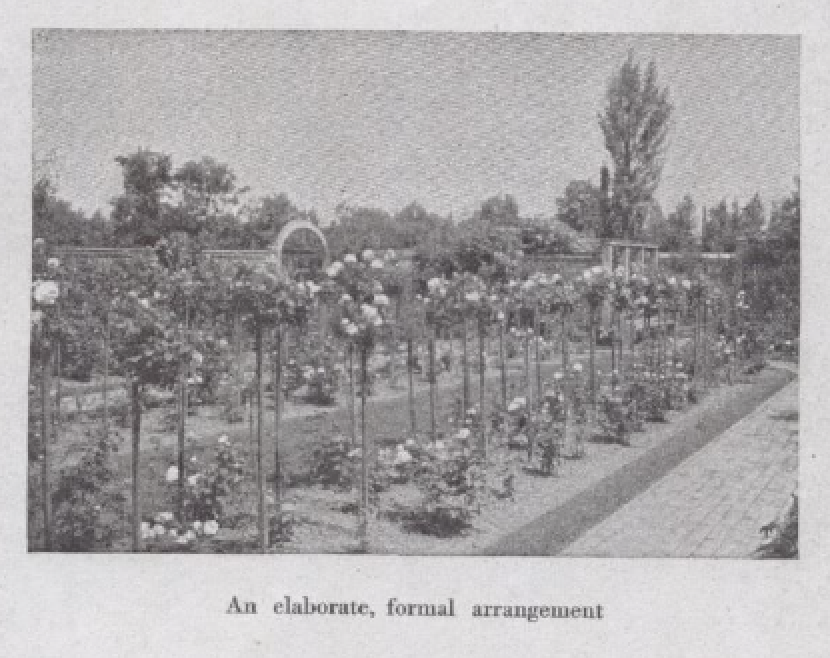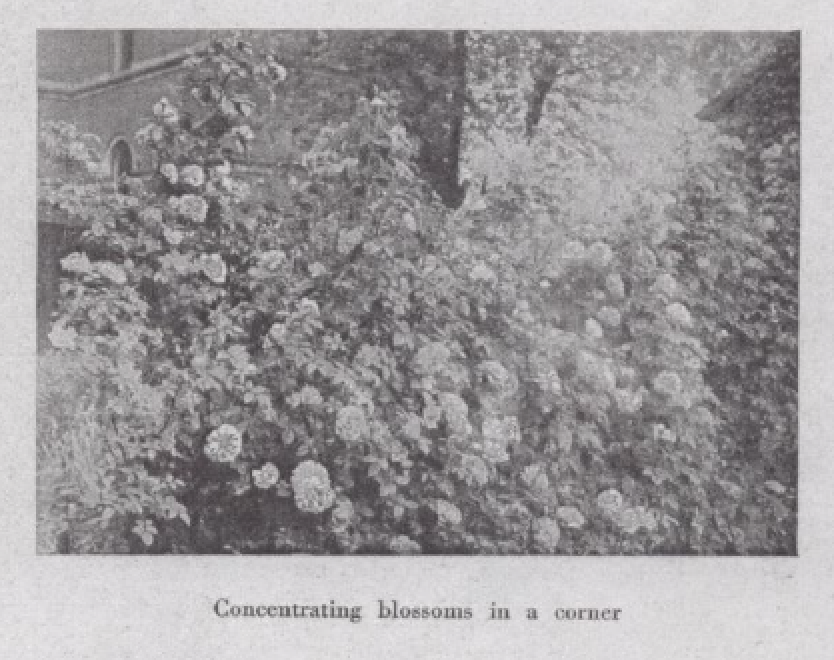Making a rose garden.
"Making a rose garden." Harper's Bazaar 47, no. 3?
(March 1913): 132.
[https://library-projects.providence.edu/rosarium/view?docId=tei/rg0012.xml]

Once the luxury of the specialist, now the joy of the amateur
The best varieties and their treatment
There was a time—in the olden days—when there were few varieties of roses and but the three families, and it was the custom to plant roses indiscriminately about the garden, just as one’s fancy dictated. But to-day with the large number of families and the innumerable varieties we have reached the place where we make whole gardens of this one flower. This is the best way when there is sufficient room to do, as they are best appreciated when one family or variety comes with others.
The principal rose families are the following: Tea roses, Hybrid Tea, Bourbon China, Polyantha, Tea-scented Polyantha, Climbing Tea, Climbing Hybrid Tea, Hybrid Perpetual, Hybrid Rugosa, Moss, Hardy Climber, Wichuraiana, Hybrid Wichuraiana, Hybrid Sweetbriers, and the real wild rose. From this list of families, each of which is divided into thousands of varieties, we can make a selection of any reasonable number for almost any purpose to which it is possible to put a growing rose. Some of these families have recognized subdivisions, such as the Hybrid Climbers, in which the Rambler subfamily holds a distinctive position. In the Hybrid Perpetual family will be found the distinctive Baby Ramblers, the finest of all hedge roses where low effects are desired.
Rose-growing among amateurs in this country is virtually in its infancy. In Europe every one who has a garden grows quantities of roses, and this is especially true of the south of England, where are to be seen vistas of miles of rose hedges, and in most cases when grown in gardens they are gardens filled with roses alone.
The rose is an old flower. It has existed in some form as long as known civilization. But the rose of ancient song and story was in most cases the rose which we now call the Sweetbrier. This is a single flower, excepting in Persia, where they have had for centuries one type of semi-double rose which is very fragrant and from which the famed attar-of-roses is made. Such flowers as the modern Frau Karl Druschki, Killarney, and William R. Smith were never seen or conceived of by our ancient rose-lovers.
One of the greatest advantages of growing roses in a garden by themselves is that they can have the specialized treatment which the modern rose demands, with the minimum of expense and labor. Since good drainage is the first principle in all modern gardening, it can be best obtained and maintained when the roses are grown by themselves in soil, beds, and borders especially prepared for them. It enables us to plant our roses in borders which are trenched and underdrained, and in beds which have had the same treatment, and when the soil needs renewing we merely turn it out of the trenches and put in some which has been specially prepared for the rose.
The trenches for the beds and borders are made by excavating to a depth of not less than eighteen inches, keeping the good soil and throwing aside the subsoil. The bottom of the trench should be graded uniformly level. sloping down toward one end, where an outlet may be made if needed. In the bottom put four inches of drainage, which may consist of any mineral detritus, such as broken stones, bricks, or the coarser cinders from the furnace. On this put the soil, which should be especially rich in humus, or vegetable matter. This humus may be put in a soil, in which it is deficient, in the form of well-rotted manure, leaf mold, or chopped sods.
Especially good are sods from a field in which clover has been growing within two years, as this will be filled with a mass of fibrous roots and the beneficent soil bacteria so necessary to fertility. To make a new soil from a base you can use any good garden loam, one third; sods, one third; and well-rotted manure, one third. Cow manure is the best for roses, but for few other flowers. This should be well mixed together, and to one bushel of the mixture add one quart of bone meal and one pint of powdered lime. Mix again, and if the soil base be a stiff limestone loam add sufficient sand to make it friable. Pile this soil mixture under cover until ready to be used.
Roses for spring planting should be ordered now, keeping in mind that the early orders get the best stock. The plantsman will know from your latitude the proper time to ship them if you do not know it yourself. Nothing is to be gained by planting the tea and ever-blooming summer roses too early, as a back-set from a late frost will do them considerable harm and may kill them. The hardy roses should be set out as soon as the soil can be worked, and you should insist that hardy perpetual roses be shipped to you dormant, and not with inch-long buds, all of which will drop off and delay the budding and blooming. The stalks should be straight and be root-budded or grafted, while the tender roses are best on their own roots.
Roses are used in many forms for beautifying the house and garden. They are grown on pillars, for which there are special varieties; in tall hedges, for which the Rugosa roses and the English Sweetbriers are the best; on porches, for which use any of the Prairie Belle family or any of the tall Ramblers; to cover arches and pergolas, for which there are numerous fine climbers to suit any climate from the tender Marechal Neil for the extreme south to the Crimson Rambler, which will stand great cold.
The Baby Ramblers make exquisite hedges and groups, as they bloom from June until the frost kills them, being the best example of the long-desired “ever-blooming” rose. Rose hedges can be trimmed into shapes as easily as the common privet and can be planted in solid colors or variegated for bizarre effects. The hardy perennial roses are mostly planted in beds and borders two feet apart, and the tender summer blooming ones, being more slender, a foot apart.
When the hardy roses come, if they have not been pruned this must be carefully done. As the blooms of this season come only on the wood grown this spring, cutting them back to three eyes or buds on each stem will give more and finer roses. The Rambler roses bloom on last year’s wood, on which account they must be pruned, any desired amount, just after they have ceased to bloom. The tender roses should be cut back slightly in midsummer. The soil should be given a dusting of bone meal and kept well worked, and they will bloom with renewed vigor.
The tender roses, of course, are taken indoors in the winter, while the hardy ones are protected outdoors as much as may be needed. As a rule, roses get more protection than is good for them. Merely wrap them loosely in building-paper so that snow and ice will not freeze on them. Do not wrap them tightly with straw or put manure about them, but hill them up so as to turn away any excess of surface water.
Water your roses freely during the growing season.


